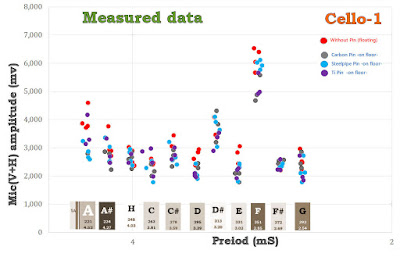[ 10/29/2019 ] Labels: 85.Solution & Study4
Resonance for A(221Hz)-G(393Hz) notes on A string was also studied by playing CELLO-2, and compared the amplitude at vertical microphone and horizontal microphone and endpin tip. Moreover, the effect of tailpiece weight and endpin length were also checked briefly.
The cello-2, about 115-year-old instrument, is presumed to be composed by stiff wood body, the measured results seem rather less clear or contentious. However the chart says; (1)The endpin resonates well when the endpin-tip is restricted on the floor similar as Cello-1 measurement. (2)Increased weight of tailpiece probably shrinks the cello body amplitude slightly in general. (3)Endpin length seems bringing in a minor effect too.
A tailpiece vibrates suspended between the bridge and the saddle(/end-rest), can sometimes take a distinct resonance to specific frequencies. A tailpiece can transmit the vibration energy to the endpin also get a counteraction from it. Generally speaking, when several materials can share the vibration(resonance), at the same time there is also a few chance to fail to. If it fails, the material might act as a mute.
A線上のA-G音について Cello-2 を使用して同様に、マイク(V方向)、マイク(H方向)、エンドピン先端 の振動強度(オシロスコープの振幅)を比較した。合わせて参考に、テールピースの質量の影響・エンドピン長さの影響を調べた。
このCello-2は 製作後100年以上経過しており、木も固く変化しているようであり、全体として差の少ない結果となっている。しかしCello-1と同様に、チェロを床置きしてエンドピンの先端が固定されることにより、エンドピンが大きく(強く)振動している特徴は同じであり、これが最も顕著な特色である。
さらに、エンドピンの共振に伴ってチェロ胴体の振動は全体に若干弱められているように見える。また、テールピースの質量が増すと胴体の響きにマイナス効果があるように見える。軽いテールピースが楽器の響きにプラスに貢献するようだという経験則とも合致する。エンドピンの長さも若干ではあるが影響を及ぼしているようである。
テールピースは 駒とサドルの間で揺れて振動する。実際に特定の周波数に対して顕著に共振するようであり注意が必要だ。特にエンドピンが大きく共振する場合はテールピースの共振も無視できなくなる。エンドピンの共振のためのエネルギーは、主にこのルート(テールピース・テールガット経由)でもたらされると考えられる。
また、複数の部材が共振するということは、別の見方をすれば、たまたま共振に失敗することも起こり得るので、「不確定性」をももたらすと考えるべきである。共振に失敗した場合、それらの部材はおそらくミュート効果として働くだろう。

































